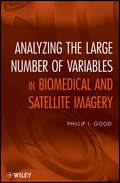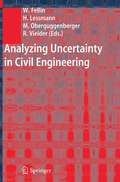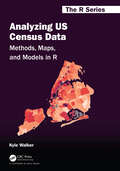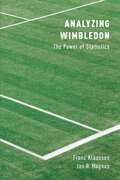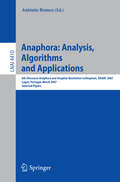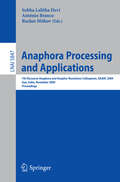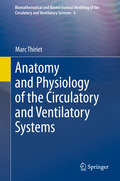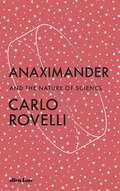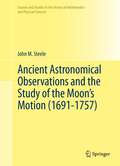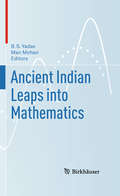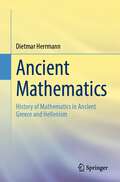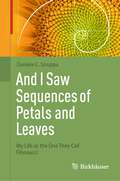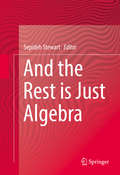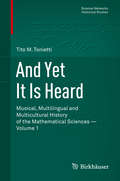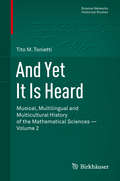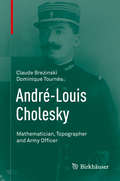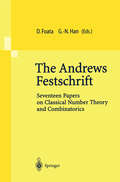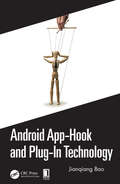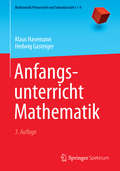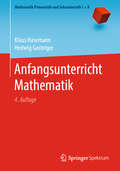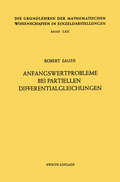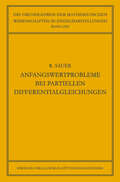- Table View
- List View
Analyzing the Large Number of Variables in Biomedical and Satellite Imagery
by Phillip I. GoodThis book grew out of an online interactive offered through statcourse.com, and it soon became apparent to the author that the course was too limited in terms of time and length in light of the broad backgrounds of the enrolled students. The statisticians who took the course needed to be brought up to speed both on the biological context as well as on the specialized statistical methods needed to handle large arrays. Biologists and physicians, even though fully knowledgeable concerning the procedures used to generate microaarrays, EEGs, or MRIs, needed a full introduction to the resampling methods—the bootstrap, decision trees, and permutation tests, before the specialized methods applicable to large arrays could be introduced. As the intended audience for this book consists both of statisticians and of medical and biological research workers as well as all those research workers who make use of satellite imagery including agronomists and meteorologists, the book provides a step-by-step approach to not only the specialized methods needed to analyze the data from microarrays and images, but also to the resampling methods, step-down multi-comparison procedures, multivariate analysis, as well as data collection and pre-processing. While many alternate techniques for analysis have been introduced in the past decade, the author has selected only those techniques for which software is available along with a list of the available links from which the software may be purchased or downloaded without charge. Topical coverage includes: very large arrays; permutation tests; applying permutation tests; gathering and preparing data for analysis; multiple tests; bootstrap; applying the bootstrap; classification methods; decision trees; and applying decision trees.
Analyzing the Large Number of Variables in Biomedical and Satellite Imagery
by Phillip I. GoodThis book grew out of an online interactive offered through statcourse.com, and it soon became apparent to the author that the course was too limited in terms of time and length in light of the broad backgrounds of the enrolled students. The statisticians who took the course needed to be brought up to speed both on the biological context as well as on the specialized statistical methods needed to handle large arrays. Biologists and physicians, even though fully knowledgeable concerning the procedures used to generate microaarrays, EEGs, or MRIs, needed a full introduction to the resampling methods—the bootstrap, decision trees, and permutation tests, before the specialized methods applicable to large arrays could be introduced. As the intended audience for this book consists both of statisticians and of medical and biological research workers as well as all those research workers who make use of satellite imagery including agronomists and meteorologists, the book provides a step-by-step approach to not only the specialized methods needed to analyze the data from microarrays and images, but also to the resampling methods, step-down multi-comparison procedures, multivariate analysis, as well as data collection and pre-processing. While many alternate techniques for analysis have been introduced in the past decade, the author has selected only those techniques for which software is available along with a list of the available links from which the software may be purchased or downloaded without charge. Topical coverage includes: very large arrays; permutation tests; applying permutation tests; gathering and preparing data for analysis; multiple tests; bootstrap; applying the bootstrap; classification methods; decision trees; and applying decision trees.
Analyzing Uncertainty in Civil Engineering
by Wolfgang Fellin Heimo Lessmann Michael Oberguggenberger Robert VieiderAnalyzing US Census Data: Methods, Maps, and Models in R (Chapman & Hall/CRC The R Series)
by Kyle WalkerCensus data are widely used by practitioners to understand demographic change, allocate resources, address inequalities, and make sound business decisions. Until recently, projects using US Census data have required proficiency with multiple web interfaces and software platforms to prepare, map, and present data products. This book introduces readers to tools in the R programming language for accessing and analyzing Census data, helping analysts manage these types of projects in a single computing environment. Chapters in this book cover the following key topics: • Rapidly acquiring data from the decennial US Census and American Community Survey using R, then analyzing these datasets using tidyverse tools; • Visualizing US Census data with a wide range of methods including charts in ggplot2 as well as both static and interactive maps; • Using R as a geographic information system (GIS) to manage, analyze, and model spatial demographic data from the US Census; • Working with and modeling individual-level microdata from the American Community Survey’s PUMS datasets; • Applying these tools and workflows to the analysis of historical Census data, other US government datasets, and international Census data from countries like Canada, Brazil, Kenya, and Mexico. Kyle Walker is an associate professor of geography at Texas Christian University, director of TCU’s Center for Urban Studies, and a spatial data science consultant. His research focuses on demographic trends in the United States, demographic data visualization, and software tools for open spatial data science. He is the lead author of a number of R packages including tigris, tidycensus, and mapboxapi.
Analyzing US Census Data: Methods, Maps, and Models in R (Chapman & Hall/CRC The R Series)
by Kyle WalkerCensus data are widely used by practitioners to understand demographic change, allocate resources, address inequalities, and make sound business decisions. Until recently, projects using US Census data have required proficiency with multiple web interfaces and software platforms to prepare, map, and present data products. This book introduces readers to tools in the R programming language for accessing and analyzing Census data, helping analysts manage these types of projects in a single computing environment. Chapters in this book cover the following key topics: • Rapidly acquiring data from the decennial US Census and American Community Survey using R, then analyzing these datasets using tidyverse tools; • Visualizing US Census data with a wide range of methods including charts in ggplot2 as well as both static and interactive maps; • Using R as a geographic information system (GIS) to manage, analyze, and model spatial demographic data from the US Census; • Working with and modeling individual-level microdata from the American Community Survey’s PUMS datasets; • Applying these tools and workflows to the analysis of historical Census data, other US government datasets, and international Census data from countries like Canada, Brazil, Kenya, and Mexico. Kyle Walker is an associate professor of geography at Texas Christian University, director of TCU’s Center for Urban Studies, and a spatial data science consultant. His research focuses on demographic trends in the United States, demographic data visualization, and software tools for open spatial data science. He is the lead author of a number of R packages including tigris, tidycensus, and mapboxapi.
Analyzing Wimbledon: The Power of Statistics
by Franc Klaassen Jan R. MagnusThe game of tennis raises many questions that are of interest to a statistician. Is it true that beginning to serve in a set gives an advantage? Are new balls an advantage? Is the seventh game in a set particularly important? Are top players more stable than other players? Do real champions win the big points? These and many other questions are formulated as "hypotheses" and tested statistically. Analyzing Wimbledon also discusses how the outcome of a match can be predicted (even while the match is in progress), which points are important and which are not, how to choose an optimal service strategy, and whether "winning mood" actually exists in tennis. Aimed at readers with some knowledge of mathematics and statistics, the book uses tennis (Wimbledon in particular) as a vehicle to illustrate the power and beauty of statistical reasoning.
Anaphora: 6th Discourse Anaphora and Anaphor Resolution Colloquium, DAARC 2007, Lagos Portugal, March 29-30, 2007, Selected Papers (Lecture Notes in Computer Science #4410)
by António BrancoThis book constitutes revised selected papers of the 6th Discourse Anaphora and Anaphor Resolution Colloquium, DAARC 2007, held in Lagos, Portugal in March 2007. The 13 revised full papers are organized in topical sections on human processing and performance, language analysis and representation, resolution methodology and algorithms, as well as computational systems and applications.
Anaphora Processing and Applications: 7th Discourse Anaphora and Anaphor Resolution Colloquium, DAARC 2009 Goa, India, November 5-6, 2009 Proceedings (Lecture Notes in Computer Science #5847)
by Lalitha Devi Sobha António Branco Ruslan MitkovDistribution of anaphora in natural language and the complexity of its resolution have resulted in a wide range of disciplines focusing their research on this grammatical phenomenon. It has emerged as one of the most productive topics of multi- and int- disciplinary research such as cognitive science, artificial intelligence and human language technology, theoretical, cognitive, corpus and computational linguistics, philosophy of language, psycholinguistics and cognitive psychology. Anaphora plays a major role in understanding a language and also accounts for the cohesion of a text. Correct interpretation of anaphora is necessary in all high-level natural language pr- essing applications. Given the growing importance of the study of anaphora in the last few decades, it has emerged as the frontier area of research. This is evident from the high-quality th submissions received for the 7 DAARC from where the 10 excellent reports on - search findings are selected for this volume. These are the regular papers that were presented at DAARC.
Anatomy and Physiology of the Circulatory and Ventilatory Systems (Biomathematical and Biomechanical Modeling of the Circulatory and Ventilatory Systems #6)
by Marc ThirietTogether, the volumes in this series present all of the data needed at various length scales for a multidisciplinary approach to modeling and simulation of flows in the cardiovascular and ventilatory systems, especially multiscale modeling and coupled simulations. The cardiovascular and respiratory systems are tightly coupled, as their primary function is to supply oxygen to, and remove carbon dioxide from, the body's cells. Because physiological conduits have deformable and reactive walls, macroscopic flow behavior and prediction must be coupled to nano- and microscopic events in a corrector scheme of regulated mechanism. Therefore, investigation of flows of blood and air in physiological conduits requires an understanding of the biology, chemistry, and physics of these systems, together with the mathematical tools to describe their functioning in quantitative terms. The present volume focuses on macroscopic aspects of the cardiovascular and respiratory systems in normal conditions, i.e., anatomy and physiology, as well as the acquisition and processing of medical images and physiological signals.
Anaximander: And the Nature of Science
by Carlo RovelliNow widely available in English for the first time, this is Carlo Rovelli's first book: the thrilling story of a little-known man who created one of the greatest intellectual revolutions Over two thousand years ago, one man changed the way we see the world.Since the dawn of civilization, humans had believed in the heavens above and the Earth below. Then, on the Ionian coast, a Greek philosopher named Anaximander set in motion a revolution. He not only conceived that the Earth floats in space, but also that animals evolve, that storms and earthquakes are natural, not supernatural, that the world can be mapped and, above all, that progress is made by the endless search for knowledge. Carlo Rovelli's first book, now widely available in English, tells the origin story of scientific thinking: our rebellious ability to reimagine the world, again and again.Translated by Marion Lignana Rosenberg
Ancient Astronomical Observations and the Study of the Moon’s Motion (Sources and Studies in the History of Mathematics and Physical Sciences)
by John M. SteeleThe discovery of a gradual acceleration in the moon’s mean motion by Edmond Halley in the last decade of the seventeenth century led to a revival of interest in reports of astronomical observations from antiquity. These observations provided the only means to study the moon’s ‘secular acceleration’, as this newly-discovered acceleration became known. This book contains the first detailed study of the use of ancient and medieval astronomical observations in order to investigate the moon’s secular acceleration from its discovery by Halley to the establishment of the magnitude of the acceleration by Richard Dunthorne, Tobias Mayer and Jérôme Lalande in the 1740s and 1750s. Making extensive use of previously unstudied manuscripts, this work shows how different astronomers used the same small body of preserved ancient observations in different ways in their work on the secular acceleration. In addition, this work looks at the wider context of the study of the moon’s secular acceleration, including its use in debates of biblical chronology, whether the heavens were made up of æther, and the use of astronomy in determining geographical longitude. It also discusses wider issues of the perceptions and knowledge of ancient and medieval astronomy in the early-modern period. This book will be of interest to historians of astronomy, astronomers and historians of the ancient world.
Ancient Indian Leaps into Mathematics
by B. S. Yadav and Man MohanB.S. Yadav and Man MohanThis book presents contributions of mathematicians covering topics from ancient India, placing them in the broader context of the history of mathematics. Although the translations of some Sanskrit mathematical texts are available in the literature, Indian contributions are rarely presented in major Western historical works. Yet some of the well-known and universally-accepted discoveries from India, including the concept of zero and the decimal representation of numbers, have made lasting contributions to the foundation of modern mathematics. Through a systematic approach, this book examines these ancient mathematical ideas that were spread throughout India, China, the Islamic world, and Western Europe.
Ancient Mathematics: History of Mathematics in Ancient Greece and Hellenism
by Dietmar HerrmannThe volume contains a comprehensive and problem-oriented presentation of ancient Greek mathematics from Thales to Proklos Diadochos. Exemplarily, a cross-section of Greek mathematics is offered, whereby also such works of scientists are appreciated in detail, of which no German translation is available. Numerous illustrations and the inclusion of the cultural, political and literary environment provide a great spectrum of the history of mathematical science and a real treasure trove for those seeking biographical and contemporary background knowledge or suggestions for lessons or lectures. The presentation is up-to-date and realizes tendencies of recent historiography. In the new edition, the central chapters on Plato, Aristotle and Alexandria have been updated. The explanations of Greek calculus, mathematical geography and mathematics of the early Middle Ages have been expanded and show new points of view. A completely new addition is a unique illustrated account of Roman mathematics. Also newly included are several color illustrations that successfully illustrate the book's subject matter. With more than 280 images, this volume represents a richly illustrated history book on ancient mathematics.
And I Saw Sequences of Petals and Leaves: My Life as the One They Call Fibonacci
by Daniele C. StruppaIn this captivating historical novel, Daniele Struppa skillfully weaves a fictional autobiography, bringing Fibonacci to life with vivid details of his upbringing and adult years in Medieval Europe. As we explore the historical context of Fibonacci's time, we delve into the intriguing aspects of a bygone era, painting a compelling picture of a man whose contributions to mathematics continue to resonate today. From his groundbreaking work on congruent numbers to the famous numerical sequence that bears his name, the author invites readers to imagine the creative sparks that ignited Fibonacci's mathematical innovations. When historical evidence is elusive, accuracy and passion are seamlessly combined, offering plausible scenarios grounded in documented facts. A meticulously crafted apparatus of notes distinguishes fact from fiction, providing readers with a clear guide to navigate this enthralling reconstruction of Fibonacci's life. Step into the medieval world of Leonardo Fibonacci, one of the most celebrated mathematicians in history, and discover the man behind the mathematical genius. Mathematicians and curious readers alike will appreciate the allure of Fibonacci's mathematical brilliance.
And the Rest is Just Algebra
by Sepideh StewartThis book addresses college students' weak foundation in algebra, its causes, and potential solutions to improve their long-term success and understanding in mathematics as a whole. The authors, who are experts in a wide variety of fields, emphasize that these difficulties are more complex than just forgotten rules, and offer strategic approaches from a number of angles that will increase the chances of student understanding. Instructors who are frustrated with their students’ lack of skills and knowledge at college level will find this volume helpful, as the authors confront the deeper reasons why students have difficulties with Algebra and reveal how to remedy the issue.
And Yet It Is Heard: Musical, Multilingual and Multicultural History of the Mathematical Sciences - Volume 1 (Science Networks. Historical Studies #46)
by Tito M. ToniettiWe bring into full light some excerpts on musical subjects which were until now scattered throughout the most famous scientific texts. The main scientific and musical cultures outside of Europe are also taken into consideration. The first and most important property to underline in the scientific texts examined here is the language they are written in. This means that our multicultural history of the sciences necessarily also becomes a review of the various dominant languages used in the different historical contexts. In this volume, the history of the development of the sciences is told as it happened in real contexts, not in an alienated ideal world.
And Yet It Is Heard: Musical, Multilingual and Multicultural History of the Mathematical Sciences - Volume 2 (Science Networks. Historical Studies #47)
by Tito M. ToniettiWe bring into full light some excerpts on musical subjects which were until now scattered throughout the most famous scientific texts. The main scientific and musical cultures outside of Europe are also taken into consideration. The first and most important property to underline in the scientific texts examined here is the language they are written in. This means that our multicultural history of the sciences necessarily also becomes a review of the various dominant languages used in the different historical contexts. In this volume, the history of the development of the sciences is told as it happened in real contexts, not in an alienated ideal world.
André-Louis Cholesky: Mathematician, Topographer and Army Officer
by Claude Brezinski Dominique TournèsThis book traces the life of Cholesky (1875-1918), and gives his family history. After an introduction to topography, an English translation of an unpublished paper by him where he explained his method for linear systems is given, studied and replaced in its historical context. His other works, including two books, are also described as well as his involvement in teaching at a superior school by correspondence. The story of this school and its founder, Léon Eyrolles, are addressed. Then, an important unpublished book of Cholesky on graphical calculation is analyzed in detail and compared to similar contemporary publications. The biography of Ernest Benoit, who wrote the first paper where Cholesky´s method is explained, is provided. Various documents, highlighting the life and the personality of Cholesky, end the book.
The Andrews Festschrift: Seventeen Papers on Classical Number Theory and Combinatorics
by Dominique Foata Guo-Niu HanAndroid App-Hook and Plug-In Technology
by Jianqiang BaoThis book presents the Android plug-in technology used in Android development. This technology is widely used by a majority of Chinese internet companies, and is becoming more widely used worldwide. The book fully describes the history of Android plug-in technology, the installation and startup process, and new features of the Android plug-in technology. It also explores plug-in solutions for peripheral technologies. The book is designed to help Android app developers better understand the underlying technology of the Android system. Features Introduces Android system knowledge, including the communication between AMS and four components Describes the Hook technique by Proxy.newProxyInstance and reflection, to modify Android system behavior, for example, to launch an activity not declared in the AndroidManifest. Shows how to use the Hook apk packaging process in Gradle Covers how to merge the resources in the plugin app and the host app, and how to merge dex of the host app and all the plugin apps Presents the SO technique and how to launch SO files dynamically
Android App-Hook and Plug-In Technology
by Jianqiang BaoThis book presents the Android plug-in technology used in Android development. This technology is widely used by a majority of Chinese internet companies, and is becoming more widely used worldwide. The book fully describes the history of Android plug-in technology, the installation and startup process, and new features of the Android plug-in technology. It also explores plug-in solutions for peripheral technologies. The book is designed to help Android app developers better understand the underlying technology of the Android system. Features Introduces Android system knowledge, including the communication between AMS and four components Describes the Hook technique by Proxy.newProxyInstance and reflection, to modify Android system behavior, for example, to launch an activity not declared in the AndroidManifest. Shows how to use the Hook apk packaging process in Gradle Covers how to merge the resources in the plugin app and the host app, and how to merge dex of the host app and all the plugin apps Presents the SO technique and how to launch SO files dynamically
Anfangsunterricht Mathematik (Mathematik Primarstufe und Sekundarstufe I + II)
by Klaus Hasemann Hedwig GasteigerEs gibt zahlreiche wissenschaftliche Studien, die zeigen, wie wichtig frühe mathematische Kenntnisse für den späteren Lernerfolg sind. Der mathematische Anfangsunterricht hat deshalb für die Lernentwicklung der Kinder richtungweisende Bedeutung, wobei die individuellen Kenntnisse und Fähigkeiten der Kinder berücksichtigt werden müssen. Dieses Buch widmet sich deshalb zunächst der Entwicklung des mathematischen Verständnisses von den ersten Lebensjahren bis zum Schuleintritt und geht auf Möglichkeiten mathematischer Förderung im Kindergarten ein. Auf lerntheoretischer Basis werden die Inhalte des Anfangsunterrichts in der Schule – Zahlbegriffserwerb, elementares Rechnen, geometrische Fragestellungen sowie Größen und Sachrechnen - ausführlich beschrieben und in praktischen Beispielen konkretisiert. Auch spezielle Zielgruppen, wie Kinder mit Schwierigkeiten beim Mathematiklernen oder mit besonderen Begabungen werden dabei berücksichtigt. Die 3. Auflage wurde neu strukturiert. Ein besonderer Fokus der Neubearbeitung lag auf dem Mathematiklernen im Übergang vom Kindergarten zur Grundschule. Zudem wurden zahlreiche neue Erkenntnisse aus dem Bereich der Vorkenntnisuntersuchungen, der Arbeit mit lernschwachen Kindern und zum Mathematiklernen allgemein eingearbeitet.
Anfangsunterricht Mathematik (Mathematik Primarstufe und Sekundarstufe I + II)
by Klaus Hasemann Hedwig GasteigerEs gibt zahlreiche wissenschaftliche Studien, die zeigen, wie wichtig frühe mathematische Kenntnisse für den späteren Lernerfolg sind. Der mathematische Anfangsunterricht hat deshalb richtungweisende Bedeutung. Für eine gelingende mathematische Lernentwicklung der Kinder ist es wichtig, die individuellen Kenntnisse und Fähigkeiten der Kinder zu kennen, um daran anknüpfen zu können. Dieses Buch widmet sich deshalb zunächst der Entwicklung des mathematischen Verständnisses in den ersten Lebensjahren bis zum Schuleintritt und geht auf Möglichkeiten mathematischer Förderung in Kindertagesstätten ein. Auf fachdidaktischer und lerntheoretischer Basis werden die Inhalte des Anfangsunterrichts in der Schule – Zahlbegriffserwerb, elementares Rechnen, geometrische Fragestellungen sowie Größen und Sachrechnen – ausführlich beschrieben und in praktischen Beispielen konkretisiert. Schwerpunkte sind dabei die Arbeit mit geeigneten Arbeitsmitteln und mit digitalen Medien. Im Fokus der unterrichtlichen Arbeit stehen Kinder mit verschiedenen Voraussetzungen und Fähigkeiten. Deshalb werden auch spezielle Zielgruppen wie Kinder mit Schwierigkeiten beim Mathematiklernen oder mit besonderen Begabungen berücksichtigt. In dieser 4. Auflage sind neben etlichen Farbabbildungen und kleineren inhaltlichen Änderungen auch Abschnitte zu elektronischen Arbeitsmitteln hinzugekommen. Hier liegt der Fokus auf Potenzial und Einsatzmöglichkeiten von Tablets und interaktiven Whiteboards, wobei auch erste Erfahrungen bei ihrem Einsatz im mathematischen Anfangsunterricht diskutiert werden.
Anfangswertprobleme bei Partiellen Differentialgleichungen (Grundlehren der mathematischen Wissenschaften #62)
by Robert SauerAnfangswertprobleme bei Partiellen Differentialgleichungen (Grundlehren der mathematischen Wissenschaften #62)
by Robert SauerDas vorliegende Buch behandelt Anfangswertprobleme, die bei partiellen Differentialgleichungen und Differentialgleichungssystemen vom hyperbolischen Typus auftreten. Nach dem einführenden Kapitel I, in dem an einfachen Beispielen Anfa. ngswert- und Randwertprobleme gegenübergestellt werden, und dem vorbereitenden Kapitel II, das eine kurze Darstellung der Charakteristikentheorie der Differential gleichung erster Ordnung enthält, sind die beiden Hauptkapitel III und IV den Systemen quasilinearer Differentialgleichungen erster Ord nung und der Differentialgleichung zweiter Ordnung gewidmet. In Kapitel Irr werden diese Probleme bei zwei unabhängigen Veränder lichen, in Kapitel IV bei mehr als zwei unabhängigen Veränderlichen behandelt. Hyperbolische Anfangswertprobleme treten in allen Gebieten der Physik und Technik auf, die es mit Wellenausbreitungs- und Aus strahlungsvorgängen zu tun haben. Ein besonders umfassendes An wendungsgebiet der Systeme quasilinearer Differentialgleichungen ist die Strömungslehre kompressibler Medien, die man kurz als Gasdynamik zu bezeichnen pflegt. Ein wesentliches Ziel dieses Buches soll es sein, dem Physiker und Ingenieur das erforderliche mathematische Rüstzeug in einer ihm angemessenen Weise zu vermitteln. Im Sinne dieser Ziel setzung wird durchwegs versucht, die grundlegenden Begriffe der Theorie geometrisch und physikalisch zu veranschaulichen und an analogen Fragen bei Differenzengleichungen zu verdeutlichen. Aus dem selben Grunde ist den Anwendungen, insbesondere aus dem Gebiet der Gasdynamik, sowie der Darlegung numerischer und graphischer Näherungsmethoden (Differenzenverfahren, Gitterkonstruktionen) ein breiterer Raum zugewiesen, als dies in mathematischen Büchern sonst üblich ist. Bezüglich der numerischen Methoden sei auch auf das als Bd. LX dieser Sammlung erschienene Buch von L. COLLATZ: Numeri sche Behandlung von Differentialgleichungen, und zwar insbesondere auf Kap. III dieses Buches, verwiesen.
